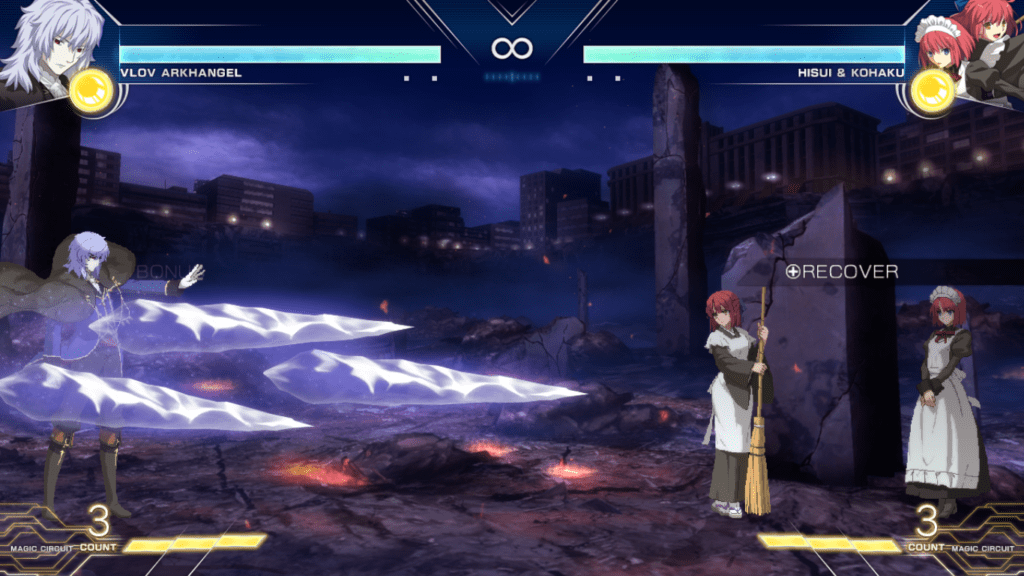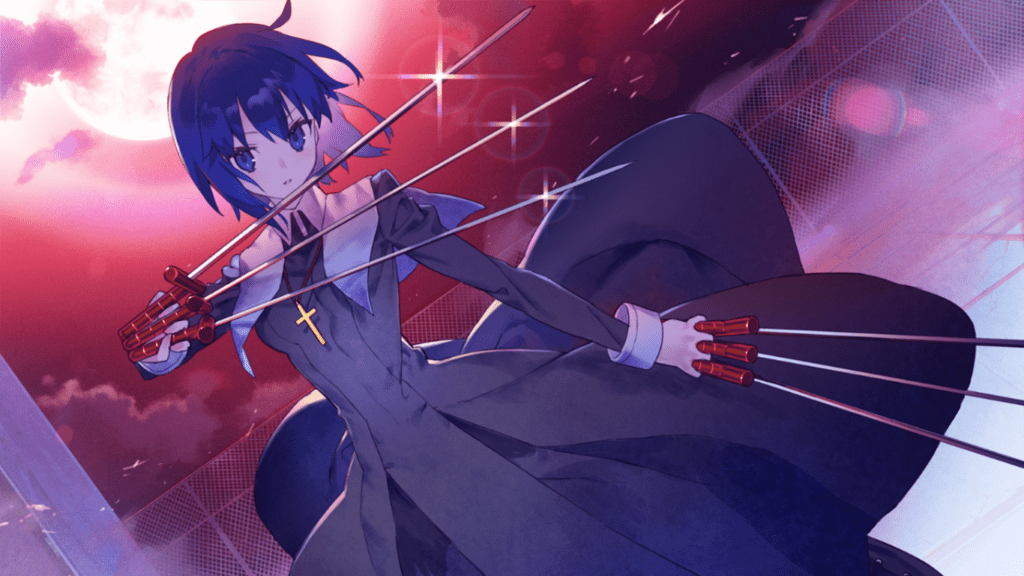Fighting games are at something of a turning point right now as developers are scrambling to fulfill the community’s demand for stable rollback netcode, and thus a whole host of new titles will be coming our way over the next few years. If Guilty Gear Strive was truly the first mainstream title to satisfy gamers with it’s netcode, along with its impossibly great animations and soundtrack, then today’s title is going to be the second to embrace this new standard and garner attention from world warriors everywhere. I wanted to explore this new fighter to see if it has more than just one crowd pleasing feature to its name, and it helps that it fits the spooky theme of our recent reviews (I’m more of an All Hallows’ Eve person myself though).

Developed by French-Bread, published by Delightworks, and released this past September (2021), Melty Blood: Type Lumina is an action-horror dueling game available on Playstation 4, Xbox One, Nintendo Switch, and PC. Its premise involves a supernatural menagerie of teenagers, vampires, and everything in between engaging in fast paced battles just below the notice of a Japanese city. Combat is the primary means of interaction with the game, with light narrative elements in the dedicated story mode. Note that this review was played on the PC version.
Before I get into the game itself, allow me to give some context surrounding the game’s existence, because I’m 90% sure none of my usual readers know what a ‘Melty Blood’ is. This small series of fighting games began life as a spin-off of a visual novel named Tsukihime (translates to “Moon Princess”) which has never seen release outside of Japan. It’s regarded by many as the first truly great visual novel and has a sizable following in Japan, but the original work is actually of the more… ahem, adult nature. This year has seen the release of the first part of a Tsukihime remake series that cleans up some of the unsafe for words stuff and shifts the series into a more action-oriented direction, and Type Lumina was released as a companion piece and a successor to the other Melty games.
This context is important when discussing Type Lumina’s story, because it is extremely light on substance. The game is effectively a non-canonical prequel to the new visual novel and clearly meant to be a mere vessel through which fans can spend extra time with their favorite characters. To play this game in the western world is to accept that your attachment to the game will likely come from the gameplay itself rather than the surface level personalities depicted by the game’s writing. Even if you make the effort to parse the ideas presented by the various personalities though, characters will sometimes act contrary to their true nature in order to be used in a comedic scenario, which may confuse overseas audiences even more. The game’s writers certainly don’t have an obligation to write with the west’s lack of attachment in mind, but it is unfortunate. Why Type-Moon, the owner of the IP, continually insists on localizing the fighting games and not the source material is a mystery (well, less of a mystery for the original), but the enduring support of the fans certainly seems to transcend the need for the full story, and speaks volumes about just how confident they were that the gameplay would carry the costs of bringing it over.
To their credit, the gameplay is definitely high quality. Melty Blood: Type Lumina is a traditional 2D fighter wherein two players select characters and seek to overcome one another through careful spacing, guard pressure mind games, and stylish combo strings. The series also falls under the umbrella of ‘airdash fighters,’ which refers to the expanded aerial movement options that alter the way neutral is approached significantly. Players new to the subgenre might find movement a bit overwhelming at first, but give it time and you’ll boot up Street Fighter and feel 100 kg heavier without a double jump. What makes fighters by French-Bread unique from similar titles are their “Reverse Beat” cancel systems, which allows players to cancel most normal attacks into any other attack not yet used in the string as opposed to the light-to-medium-to-heavy cancels present in most games. This system encourages offense to be built around long strings of attacks easy enough for anyone to accomplish, because pressing more buttons is fun!
The game is dense with various mechanics that shape its identity, so for brevity’s sake I’ll attempt to cover just the most significant ones. The biggest new addition to Type Lumina is the “Moon Gauge”, a resource that governs the use of Moon Skills and Moon Drive and is replenished after each stray hit a player lands. “Moon Skills” are easy to execute special moves with empowered properties, and are probably my favorite addition to the series’ gameplay. They’re great for beginners who are struggling to input normal specials without allowing them to spam endlessly, but they’re also great for veteran players because it lets them make more tactical decisions and utilise the stronger attributes of the Moon Skills in interesting ways. “Moon Drive” is a complex ability that pauses time on activation to allow for easier reactions, and also grants a limited time of extra air movement, jump cancel options, and Moon Skill use. This is obviously geared towards advanced players looking to create surprising mix-ups and deal extra damage, and some people have stated that it feels a little too prevalent, but I find that one can ignore this ability and just focus on Moon Skills at the casual level if it’s too much trouble.
Additionally, the game also features a reworked Shield system, which allows players to parry attacks and initiate several follow ups which require guessing on the part of their opponents to counter in kind. These sorts of mechanics are a little less enjoyable no matter what fighting game they show up in, but at least failing to get the initial parry results in a big counter-hit so it has to be used intelligently.
As for the playable characters themselves, the high impact of Melty’s universal mechanics drives most characters towards a rushdown oriented style, but enough differences exist between each fighter to make your choice meaningful. Protagonist Shiki Tohno needs to stay relatively close to his opponent to be effective but has useful tools for closing in, and landing his Boundary Peek super attack unlocks a deadly set of extra special moves for the rest of the round (or for the duration of the next round if the super was the finishing blow). The goofy maid Kohaku has a long reaching broom and fishes for knockdowns in order to set up a variety of potted plants that keep the opponent on the defensive. My personal favorite character Ciel is a well rounded vampire hunter who effortlessly switches between close quarters combat and long range keepaway with her endless supply of hidden blades.

The game is light on overall play modes, however. Each one is certainly functional and has its appeal, but they are incredibly standard and don’t really change the mechanics of the game that much. The standard versus, training, and mission modes are all well made, but story mode is sparse, and score attack, time attack, and survival are largely just versus mode with grading systems. I understand that in this day and age the budget of most fighting games has to go into their core mechanics and especially its animation in order to sell, but as someone who grew up playing fighters with a rich selection of modes like Super Smash Brothers and Blazblue it’s definitely tough to swallow. At least the much anticipated rollback online battle mode runs about as well as I could have hoped, considering I rely on campus wi-fi to play.
As for the game’s graphics, they are quite well made. While the three dimensional stage backgrounds are a little simple, the two dimensional character sprites are clean and animate with impact and speed that befits the game’s genre. 2D sprites are rather uncommon in fighting games these days, so I’m thrilled to see them alive and well in releases like this. What really has newcomers scratching their heads though is the character designs, as the lead up to Melty Blood: Type Lumina’s release was filled with discussion about how plain looking the characters are (and I swear if I ever have to hear the word “drip” used to describe fashion ever again I am going to actually lose my mind. If anyone says it to me, I will dump a gallon of water on said persons’ head and ask how much drip THEY have).
…In my opinion though these simpler character designs are part of what enables the animation to be as good as it is, along with being weaved together with voice acting and battles to recreate the visual novel style of storytelling. Even if most of the characters are only explored skin-deep, the simple character designs draw attention to their personalities in effective and subtle ways. Ciel and Noel may both be fantasy Catholic vampire hunting Sisters in plain dark-blue habits, but you can easily tell that Ciel is a pious and determined crusader against the dark, while her junior partner Noel is only nominally among the faithful and joined solely for the privilege of slaying monsters. Hisui and Kohaku are twin maids in service to the Tonho mansion, but it’s simple to tell Hisui’s shy yet proper demeanor from Kohaku’s trickster silliness. Arcueid Brunestud comes in two different forms which show the player that just because she can suppress her vampiric nature doesn’t mean there isn’t a truly cruel princess of the night below the smiles and playfulness.
Type Lumina’s soundtrack is also worth mentioning. Composed by French-Bread regular Raito, the game’s soundtrack is brimming with his usual synth-rock flair along with Melty’s signature jazz fusion. With that being said, I don’t think it quite lives up to his work on the older Melty Blood games or his absolutely stellar Under Night In-Birth soundtrack. These games have generally used short, looping songs to accompany the fights, but their soundtracks reveal their quality when you realize how little you care that it loops quickly. Type Lumina unfortunately has fewer songs than usual that are fun to listen to for extended periods. The music is still quite good, it’s just that it loses its impact quicker the more you listen.
As for what I think a Catholic could get out of the game, the “darkness beneath the surface” psychological horror aspect of the game certainly brings to mind the importance of discerning spirits and seeking God’s protection, that we may never be overcome by temptations and evils that come in disguise. I also think the genre of fighting games itself is an image of perseverance in the face of a long journey. Much like those who find Catholic devotion more difficult than they thought and gaze longingly at their pious brothers and sisters, many fighting game newcomers often struggle to learn the basics of the genre and rise to the level of their friends or the players on the ranked ladder. In both cases some people fall into despair and quit, but those who really want it will seek help from their community and work to increase their virtue or skill respectively. Prayer becomes easier after doing it for a few weeks in the same way that special motions become easier after practicing for a few hours, so if you stick to your convictions both grow to be natural overtime. Don’t let the journey magnify who you are now, let it light the way to what you’ll become, be that a saint or a local champion (hopefully, both)!

So in conclusion, Melty Blood: Type Lumina is a good fighting game with exciting and surprisingly straightforward combat, great online play, and beautiful 2d sprite work. If you want a more well rounded experience with lots of modes then this one may be disappointing, especially without the context of the source material, but if you can find the fun in one really engaging core battle system then it might just leave an impression. The long term hype around the game may not be too certain with how many competitors it will have, but even if its popularity fades I will certainly remember the face-offs I had under the blue glass moon.
Scoring: 72%
Gameplay: 4/5
Art and Graphics: 4/5
Music: 4/5
Story: 1/5
Replayability: 5/5
Morality/Parental Warnings
Melty Blood: Type Lumina is a psychological horror themed game that features vampires and half/part-demon characters, though most of the characters tend to conceal their full power and true form, and no realistic demonic imagery is present. What isn’t concealed is that some of the characters actively take sadistic pleasure at the thought of killing or harming others. Battles involve a variety of melee weapons and magical abilities (the super bar is literally called the Magic Circuit), but blood is usually only drawn during specific moves like certain Arc Drives and Last Arcs. Ciel and Noel are Sisters affiliated with the Church, but the game’s setting doesn’t make much attempt to have a realistic imagining of the Church so it goes without saying that their portrayal should be taken with a grain of salt, even if Ciel is refreshingly a positive character and easily the most heroic person in the game (this is a generally good rule of thumb when dealing with depictions of Christianity in Japanese media, where the aesthetics of Church are usually appropriated because of the rule of cool and little respect is paid to accurate understanding of tradition and doctrine). The character Vlov Arkhangel is polygamous, but this is told rather than shown. Noel, Miyako Arima, and Michael Roa Valdamjong show varying degrees of skin in their designs, though you can make them somewhat more modest through the use of alternate colors. One of the guest illustrations in the gallery features the cast in swimsuits. Some foul and suggestive language is present, which contributes to some of the comedic dialogue being in poor taste.
